ASLE’s Scholar of the Month for December 2023 is Lisa Blackmore.
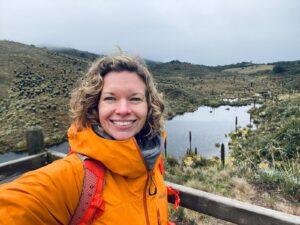
Lisa Blackmore is Senior Lecturer in Art History and Interdisciplinary Studies at the University of Essex. After obtaining her Ph.D. in Latin American Cultural Studies from Birkbeck College in 2011, she taught at universities in Venezuela and the United Kingdom and was Postdoctoral Researcher on the project “Modernity and the Landscape in Latin America: Politics, Aesthetics, Ecology” at the University of Zurich from 2014-17. Moving between practice and research in the environmental humanities, Lisa’s work encompasses curatorial and editorial projects, audiovisual production, and community and public engagement work.
Since 2018, she has convened the interdisciplinary research group entre—ríos, a confluence of projects that explores continuities between bodies of water, human bodies, and territories, recognizing rivers as active subjects that produce aesthetic forms, transform landscapes and shape memory. The collective curates exhibitions and public programs, publishes books, and commissions online digital art projects. This year, entre—ríos launched RÍO BOGOTÁ, a digital platform, series of documentaries and publication made in collaboration with communities and initiatives that care for the Bogotá river, and ran its first transnational online seminar Culturas hidrocomunes.
Lisa has recently co-edited dossiers for the Journal of Latin American Cultural Studies and MAVAE (Colombia) mapping environmental research, practice, and public engagement in Latin America, with a further volume forthcoming with LA ESCUELA__JOURNAL. She is the author of Spectacular Modernity: Dictatorship, Space and Visuality in Venezuela 1948-1958 (2017), co-director of the documentary Después de Trujillo (2016), and co-editor of Downward Spiral: El Helicoide’s Descent from Mall to Prison (2017), Natura: Environmental Aesthetics After Landscape (2018), The Politics of Culture in the Chávez Era (2019), and Liquid Ecologies in Latin American and Caribbean Art (2020), among other co-edited works.
How did you become interested in studying ecocriticism and/or the environmental humanities?
I’ve been working in the environmental humanities for about the last seven years. My background, before that, was in modern languages and Latin American cultural studies, both of which shaped the ways I’ve researched the fraught politics, landscapes, and visual cultures of modernity and their contemporary afterlives. My doctoral and postdoctoral work was motivated by a deep curiosity for the lived experience of mid-century modernity and its connections with authoritarian statecraft, modernist architecture, and political violence. This led me to trace connections between developmentalism, landscape, and dictatorship through a range of documents from archives (from official institutions and clandestine movements) and contemporary landscapes in Venezuela and the Dominican Republic. On those journeys –archival and embodied– I became fascinated by how discourses and imaginaries of national and urban development hinged on extractivist approaches to the environment, both in literal, industrial terms, and through its composition and domestication as natural “resources,” landscape, and infrastructure.
This shift in my work occurred when I was doing postdoctoral research in Zurich, as part of Jens Andermann’s project Modernity and the Landscape in Latin America. During 2016, there was an unprecedented drought in the Orinoco River basin, where Venezuela’s largest hydropower plant, Guri, was built in the 1960s –and still provides two-thirds of the nation’s energy. This sparked my interest in the repercussions that this dramatic interruption of literal infrastructural flows had for other imaginaries of flow. So, I began to analyze the environmental aesthetics of the actual landscapes of the reservoir, dam, and its run-off, alongside the industrial-sized works of kinetic art that Carlos Cruz Diez and Alejandro Otero had produced (on official commission) soon after Guri was built, and in relation to the broader optics of a nation plunged into energy blackout. The questions this raised about human-water relations became the pulse of my research into other hydropower and hydraulic infrastructures in the Dominican Republic, Brazil, and Colombia. The work also germinated my collaboration with Liliana Gómez as we developed “liquid ecologies” as a conceptual framework and analytic to study the interfaces of water and cultural production in the longue durée of modernity/coloniality, industrialization, and their related injustices in Latin America and the Caribbean.
Who is your favorite environmental artist, writer, scholar, or filmmaker? Or what is your favorite environmental text?
This is an impossible question, and I’m going to resist the category of “favorite” by giving (just) a few examples! For a number of reasons of synchronicity and synergy, I have a deep connection to the poem El río (1961) by Peruvian writer Javier Heraud, which traces the course of a river from mountain source to ocean mouth. It’s an arrestingly simple premise for a poem but one that I never tire of reading, among other things, because it conjures the fluctuating pulses and volumes of this river (an anonymous one) in ways that emphasize that as it overflows language, space, composition it always exceeds human capture. Not long before I encountered Heraud, I had seen Carolina Caycedo’s work for the first time at the Bienal de São Paulo of 2016. I was instantly struck by A gente rio, the film she was commissioned to make in the wake of the devastating tailings dam collapse on the Doce river in Minas Gerais, her critical appropriation of satellite imagery to stitch together the “tatterscape” (to use Michel Serres’ term) of wounds inflicted by extractivism, and her Libros Rio that compiled rivers through localized, deeply affective entanglements with territories. I continue to be inspired and learn from Carolina’s practice, alongside other artists I’ve been lucky to confabulate with over the past five years.
These include (but are by no means limited to) Colombian sound artist Leonel Vásquez, whose practices (such as Templo de agua: río Bogotá) for connecting through listening to other-than-human lives is deeply moving and compelling; Colombo-Venezuelan digital and installation artist, David Medina, who uses AI to create delirious flows of data (such as Es torrente y un hilo…) that are serious and hilarious in equal measures, as they reflect on our entanglement with digital technology. I also want to mention the Peruvian artists Genietta Varsi and Alejandra Ortiz de Zevallos, who we’ve been working with on workshops that ignite conversations around water stresses such as urban contamination and the loss of wetland ecosystems through, respectively, somatic practices of movement and breathwork, and weaving with plant fibers from common reeds. The generosity of all these artists in making their practices permeable to other participants is a compass for us to think about the invaluable ways that creative practice opens our sensorium to environmental histories, challenges, and potential futures.
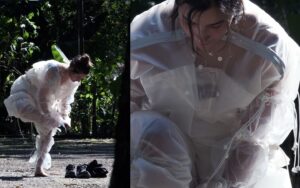
Genietta Varsi activating a “sweat suit” from her project Porosibilidades, São Paulo, 2023. Photo: Joao Machado.
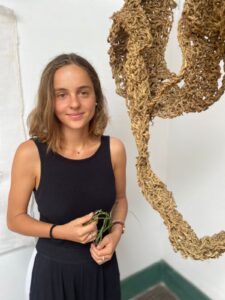
Alejandra Ortiz de Zevallos, in her studio with a sculpture woven from common reeds harvested from Lima’s Surco Canal. Photo: Lisa Blackmore, 2023.
What are you currently working on?
I’ve spent 2023 dedicated to a research project called Imagining the Hydrocommons: Water, Art and Infrastructure in Latin America, supported by a British Academy Mid-Career Fellowship. I’m writing a second monograph, tentatively titled Resurgent Water Cultures, that grows from my research into the intersections of hydropower, environmental justice, and environmental aesthetics, and my ongoing curatorial collaborations and public engagement work with artists, activists, scientists and institutions in Brazil, Colombia, and Peru. The book traces a resurgence of water cultures that simultaneously work through and move beyond scarcity, pollution, industrial disasters, and other stresses, to reclaim and imagine more just and sustainable hydrological relations. I start in a genealogical and theoretical vein, by returning to the performance practice of Venezuelan duo Yeni y Nan, whose immersions in water in the 1980s are an invitation to delve into somatic aesthetics that remind us how water is vital matter that articulates and connects lives. I then work through a series of chapters that explore how art practice and coalitions of communities and artists across Latin America are practicing modes of hydrocommoning through creative activism that advocates for the rights of nature, indigenous water cultures and more-than-human well-being. This work demonstrates that water futures depend on diverse knowledge ecologies, citizen participation and fertile imaginations.
With entre—ríos, we have been working intensely this year in Colombia, alongside co-curators Diego Piñeros García, Laura Giraldo-Martínez and Juliana Steiner, and collectives and initiatives engaged in caring for the country’s most polluted river. We commissioned anthropologist-artist culinary duo, Cristina Consuegra and Carlos Alfonso, to create a menu for a Piquete de río, a banquet that gathered guardians of the Bogotá river engaged in Indigenous Mhyusca culture and education, ecological restoration, community aqueducts, ecotourism, and food sovereignty, for a ritual banquet at the Tequendama Falls –an iconic site on the river but one now renowned for being a point where the river, as it cascades down 157 meters, is biologically dead. The menu of dishes composed of the river guardians’ memories, traditions, and research, using produce they cultivate through agroecological methods, was an encounter to galvanize energies to sustain their care work. In November this year, we launched RÍO BOGOTÁ, which enables users to navigate six points on the river, download the publication Cómo cuidar un río, watch documentaries where the river guardians talk about water health, the meal they shared, and what it means to eat a river. we’re now working toward a next stage of the project in 2024 where we plan to continue using food as a means to convene broader conversations around sociolegal protection for the river.
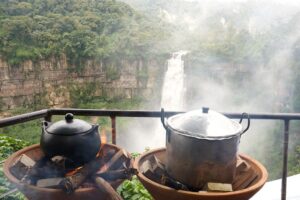
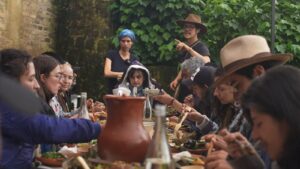
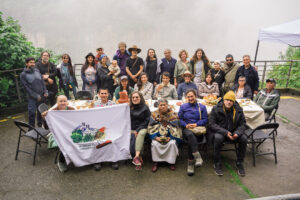
Piquete del río Bogotá, 26 April 2023. Photos: Gabriela Molano.
What is something you are reading right now that inspires you, either personally or professionally?
I’ve been recently thinking a lot about how we learn, in what conditions, and how both pedagogy and public engagement in environmental humanities can create conditions for change. This is a process that has been unfolding with a community of fellow students on a Diploma in Somatic Education that I was studying at the Universidad Javeriana in Bogotá. Somatic practice invites us to cultivate capacity and sensibilities to “read” our own bodies, to understand ourselves as soma, that is, as a human sensorium that self-senses and through that forms knowledge. Together, we have been reading and talking but also doing and moving our way through thinking about how to change and what happens when we do. I’ve been inspired by the micropolitical and deeply reflective ways that teachers on the course (such as Elena Sterenberg and Irene Rodríguez) expanded our ideas of literacy back towards gesture, posture, movement reclaiming the body as the primary site of knowledge and, obviously, the medium for relationality.
These questions of how we learn, relate and change resonate in other reading I’m doing right now, thinking through the need for environmental humanities practices to engage simultaneously in both “critique and action.” This is the impulse of Caroline Levine’s new book, The Activist Humanist: Form and Method in the Climate Crisis, which asks how the aesthetic and environmental humanities can serve not just for disassembling through cultural analysis forms of dominance but also to identify and value forms that enable collective continuance (a concept she develops from Kyle Whyte). I’ve also just finished Vanessa Machado de Oliveira’s Hospicing Modernity: Facing Humanity’s Wrongs and the Implications for Social Activism, and was enriched by the discussion of what she calls practices of “metabolic literacy,” learning that stems from embodied and contextualized experiences (hers relates to flushable toilets -of the lack thereof- in a high Andean region of Peru) that make palpable bodily entanglement with multiple modes of relationality and, here’s the vital part, through that sense of interconnection can impel more just forms of inhabiting the end of the modern project. Understanding the learning process as a “disposition” also means that the areas in which experiences and knowledge that mobilize changes multiply –moving beyond conventional sites of learning into an expanded field of continuous, relational practice that necessarily involve an ecology of knowledges.
Is there a scholar in the field who inspires you?
Again, I feel uncomfortable about singling out one person, but here are two (of what could be numerous!) examples. Through the work we’ve been doing this year with the Bogotá River, I’ve been deeply inspired by the practice of Paula Caucalí, one of the community leaders in the Escuela de Pensamiento Ambiental y de la Paz Humedal El Charquito (EPAP). Paula weaves multiple roles through her academic and community work, serving as an environmental activist engaged in restoring a wetland adjacent to the most polluted part of the Bogotá River, organizing craft activities with residents in the rural village of El Charquito, and contributing to the EPAP’s chagra madre, a garden that produces seeds distributed to more than 30 family allotments. Paula is also an emerging scholar who threads her activism through her current research project where by studying how women in her community plant certain flowers and bushes to attract particular birds she explores the ecocentric affects that bind them to local bird wildlife. To give a second example, I recently had the pleasure of interviewing Astrida Neimanis for Hydrocommons Cultures: Art, Pedagogy and Practices of Care in Latin America (the first edition of LA ESCUELA__JOURNAL, I’m editing with Alejandro Ponce de León). I’ve long been inspired by Astrida’s insistence on embodied practices of immersion and attention to waterbodies’ lives and forms as a vital part of theoretical work. I’ve been swimming and being in different bodies of water as part of my research for several years now so it’s galvanizing to how others engage and value embodied practice in scholarship. In the conversation, it was also fascinating to hear how everyday experiences inform her pedagogy and research practice, and her understanding of pedagogy as a form of activism. For me, the clarity and generosity of her deeply collaborative work is a key example of practicing care in academia.
